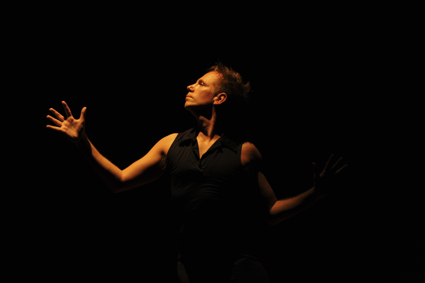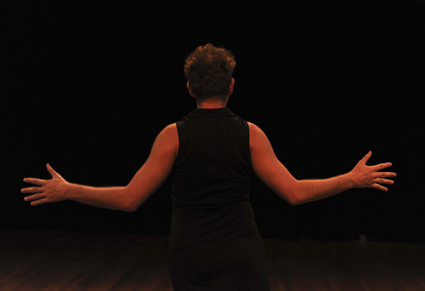Dances for a little black dress
Jodie McNeilly, interview, Martin del Amo

Martin del Amo, The Little Black Dress Suite
photo Heidrun Löhr
Martin del Amo, The Little Black Dress Suite
The ‘black dress’ is unparalleled in its iconic status as elegant, timeless, classic. One need only think of Audrey Hepburn in Breakfast at Tiffany’s to understand this powerful feminine symbol that shuttles between sexy and demure. So what is choreographer Martin del Amo doing with this fashion archetype in his direction of the four solos in The Little Black Dress Suite?
The threads are historical and cumulative. Del Amo attests that the little black dress emerged intuitively as a costume in three earlier works in very different contexts. It’s a potent, recurring element “reimagined” in this new suite of works through juxtaposition and gender disruption.
Each solo and instance of the little black dress varies in duration and musical accompaniment—noting grammatically that definite article ‘the’ refers to the single form/idea and not the use of one garment. One ‘dress’ is worn by Miranda Wheen in a collaboration with composer and musician Alex Pozniak. This relationship was established in 2012 under the direction of del Amo for Synchronicity, a co-production between Dirty Feet and Chronology Arts (see RT109). In redux, Wheen will again precariously “negotiate an imaginary environment of invisible forces” on high heels (another Del Amo symbol) in a tight, little black dress—the physical reality of her movement pushing against, yet tightening the image. In this tensile elaboration we can only ask: “is she appropriately dressed?”

Martin del Amo, The Little Black Dress Suite
photo Heidrun Löhr
Martin del Amo, The Little Black Dress Suite
A second dress, worn by del Amo himself, was unleashed in all its Bob Fosse glory at Campbelltown Arts Centre in 2010. What Good is Sitting Alone in your Room was a tribute to the Master of Jazz. An incompatible aesthetic equation—del Amo and Fosse—but one balanced through likened compositional strategies (ie isolation of body parts). Del Amo in a cocktail dress is no transvestite. Dancing del Amo dissociates ideas of the feminine from the frock and his embodiment in order to make new.
Kristina Chan wears a third dress, more in the style of Wheen’s—tight and short. This will be a new solo, something along the lines of Jane McKernan’s powerful downstage finale from Slow Dances for Fast Times (2013, see RT114). Surprisingly this is the first time del Amo has choreographed Chan in a piece and ideally not the last.
Sue Healey presents a fourth and final dress, described by del Amo as “worn in the vein of the sassy.” Developed from scratch, this work consciously starts with the dress and is informed by its final position in the suite. Long-time chorographer Healey has recently appeared as a dancer on Sydney stages, including in a duet with del Amo for the IOU Dance 2 season at UNSW. Together they have been developing a regular studio practice, born from one of del Amo’s famous performative birthday presents to dancers.
The dresses connect the solos through a stylistic and symbolic unity. Each is moved, extended and worn differently. From this coherency of eclecticism (also a del Amo trademark) individual meanings can be massaged. Musically we can expect something similar, with compositions by Alex Pozniak (with Wheen) and Gail Priest (with del Amo), whose original pieces will be placed next to an operatic aria from Mozart (for Chan). Healey’s music co-conspirator (be they dead or alive) will be revealed on the night.
The solo is a fragile and difficult mode of performance. We demand of the solo performer an attention without slack; anyone who has seen del Amo perform will attest to very little slack. This acuity of attention can be seen in the several solos he has made on others: Miranda Wheen, Paul White and the 12 dancers in Slow Dances for Fast Times.
Del Amo speaks of “schizophrenic roles” inherent in creating solo performance work. Simultaneously performer, director, dramaturg and choreographer, he battles many voices that sometimes agree, sometimes don’t. When he choreographs others in a solo, it is not a ‘del Amo possession’ we see, but the transmission of his choreographic thinking—a subtle phenomenon not always transparent to an audience. The compositional strategies and organisation of the body are migratory structures that del Amo generously shares in workshops and the rehearsal room. The dancer moves within set parameters and scores, generating material as a unique product of their attention. It is the appearance of these structures across the many solos that marks the dancer with del Amo’s signature, the mobility of his thinking from one solo to the next—elegant, timeless, classic.
Form Dance Projects: The Little Black Dress Suite, choreographer Martin del Amo, performers Martin del Amo, Miranda Wheen, Kristina Chan, Sue Healey; composers Alex Pozniak, Gail Priest, Mozart, Lennox Theatre, Riverside, Parramatta, 15-17 August; http://form.org.au/2013/01/the-little-black-dress-suite/
RealTime issue #115 June-July 2013 pg. web






